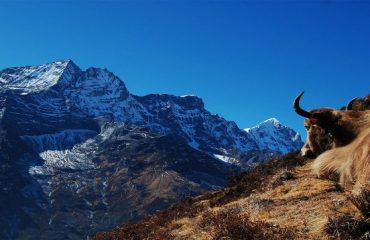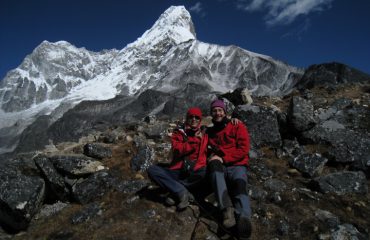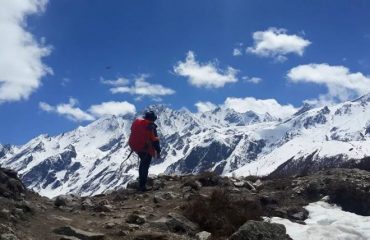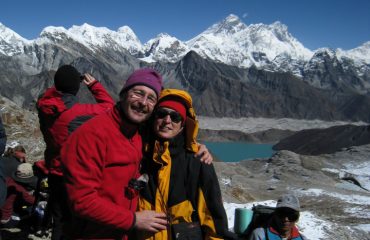NEPAL – Everest Base Camp Trek
Called as Sagarmatha “Sky Head” by Nepali and Chomolungma “The Mother ” by Tibetans, Everest is the highest peak in the world with the of 8848m. This trek that goes to the lap of Everest and is to fulfill dream of many people to experience this historic walked by legendary climbers like Sir Edmund Hillary and Tenzing Sherpa in 1954. The trail goes through the jaw dropping mountain
vista set in the backdrop of culturally rich Sherpa villages, dense offering home to diverse range of flora and fauna and furiously snow fed rivers.
-
Reviews 0 Reviews0/5
-
Vacation Style Holiday Type
-
Activity Level Challenging
-
Group Size Medium Group
This incredibly enticing trip starts from upper Phakding and following
Dudh Koshi Valley it goes to the Sherpa capital of Namche Bazaar. Namche
is the bustling bazaar and a meeting point for trekkers and local
Sherpa. From Namche the trail goes along a high traversing path and
offers a magnificent view of Everest and then head towards Tengboche
monastery. Tengboche monastery sits in the altitude of 3867m and is
surrounded by firs and Rhododendron. The monastery grants commanding
view of Everest landscape. From Tengboche we will go down to Imja Khola
and continue the walk through the villages of Pangboche and Periche
which ultimately lead us to Khumbu glacier. And following the glacier we
will trek to Lobuche which is the vantage point offering spectacular
view of Ama Dablam, Tawache along with hodgepodge of many others. From
here we will trek to Gorakshep and ultimately climb to
Kalapatthar(5545m). Kalapatthar offers spectacular panorama of regal
Himalayas which will leave you dumbfounded. We then trek down to Everest
base camp which is situated at the foot of Khumbu icefall and ultimate
make our way down to Lukla.
TREKKING INFO
Stay Safe
Altitude Sickness: The main and common risk while trekking above about
2500m is Altitude sickness. Altitude sickness is caused by acute
exposure to low partial pressure of oxygen at high altitude. The
available amount of oxygen to sustain mental and physical alertness
decreases with altitude. Available oxygen drops as the air density
itself, the number of molecules (of both oxygen and nitrogen) per given
volume, drops as altitude increases. So don’t ignore, if you have any
symptoms then descending to a lower altitude is the only option.
Water: Have some means to purify water, iodine or a fine ceramic filter
are the best options. The streams should be considered polluted and
whilst bottled water is often available, the disposal of plastic bottles
is a problem.
Electricity in Nepal
Nepal is a developing country, Outside of major cities area electricity
on trekking can be scares. You should have to pay 100-800 NRs per hour
to charge goods on many lodges and also many tea-house treks, including
in Annapurna base camp trek, Everest Base camp trek and many others
treks also. Chargers often won’t work on low power solar systems you
find right up in the mountains so u can buy alternative bayonet light to
electricity power plug converter, which will only works in low voltage
is highlow. The standard Nepalese electrical outlet is a three-pronged
triangle so bring three-pronged triangle chargers.
Nepal Climate information
Nepal is a landlocked country which lies in Hindu Kush Himalayan region.
Nepal has monsoonal climate having four main seasons: spring, summer,
monsoon, autumn and winter.
Below is a general guide to conditions at different seasons:
January to March (winter): In this season temperature will decrease at
often 0°C (32°F) at night, with extreme cold at high elevations. It is
possible to trek in places like the Everest region during the winter but
due to extreme cold weather and heavy snow fall it may be quite
difficult than as usual.
April to June (summer): In these months it is quite warm and dry
weather. There is an abundance of blooming flowers in the Himalayas at
this time, with rhododendrons, in particular, adding a splash of color
to the landscape. This season is the best time to undertake mountain
expeditions.
June to September (Monsoon): There will be heavy monsoonal rainfall in
this season. Rains are generally lighter in high Himalayan reasons. In
this season the mountain ranges are not often visible due to the clouds.
October to December (autumn): These months are cool and clear which is
due to the end of monsoon, there is little dust in the air so this is
the best season to visit the hilly and mountainous regions.
Nepal Visas information
Visa in Nepal can be acquired on arrival at Tribhuwan International
Airport, Kathmandu and also at the border entry points in Kakadvitta,
Birgunj, Bhairahawa, Nepalgunj, Gaddachowki border of Nepal – India and
Kodari on Nepal-China border. Visa can also acquire at the nearest Nepal
Embassy. For visa renewal purpose you can contact at Department of
Immigration, Kalikasthan at Kathmandu. A valid passport and one passport
-size photo with a light background is required. Visa can be obtained
only through payment of cash in the following currency: Euro, Swiss
Franc, Pound Sterling, US Dollar, Australian Dollar, Canadian Dollar,
Hong Kong Dollar, Singapore Dollar and Japanese Yen. Credit card, Indian
currency and Nepali currency are not accepted as payment of visa fee.
Visa Facility Duration Fee
Multiple entry 15 days US$ 25 or equivalent convertible currency
Multiple entry 30 days US$ 40 or equivalent convertible currency
Multiple entry 90 days US$ 100 or equivalent convertible currency
Respect to Local Peoples
In Nepal, “Namaste” or “Namaskar” is said to an older or high-status
person with palms together, figure up. It is used to greet a person in
place of goodbye or hello. There is no limitation how many times you say
“Namaste” but, it is better if you say once per person, per day. If You
want to say “Thank You” then you can say “Dhanyabaad /’ðɅnjɅbɑ:d/
(Dhan-ya-baad)”
- All Necessary transportation
- 3 meals per day during the trekking (B L D) including Tea or coffee
- Accommodation on Tea House ( Lodge ) or provided Tents during the trek as mentioned in the trek type
- Accommodation in star Hotel at Kathmandu
- High Experienced Government Licensed Guide and Necessary porter during the trek.
- All Government local Taxes
- National park Fees
- (TIMS) Trekkers Information Management System
- First Aid kit, general equipment for Porter
- Guide and porter salary
- All Filed Staff insurance during the trekking and extra services according to the guest per demand.
- Trekking equipment any type of personal expenses such as Alcoholic Beverage drinks, phone and Laundry
- Emergency Rescue and Travel Insurance, Trip Cancellation cost accident or Health, Loss Theft or Damage and personal effects. we advise you to take out personal Travel Insurance
- Tips and Gratuities.
- Cost incurred from natural disaster or unfamiliar circumstances
- Day 01 Kathmandu Arrival
- Day 02 Fly to Lukla and trek to Phakding
- Day 03 Trek to Namche Bazaar (3430m); 5-6hours
- Day 04 Acclimatization in Namche Bazaar
- Day 05 Trek to Tengboche(3867m); 5-6hours
- Day 06 Trek to Dingboche(4300m); 5-6hours
- Day 07 Acclimatization day in Dingboche
- Day 08 Trek to Lobuche(4930m); 5-6hours
- Day 09 Trek to Gorkshep(5140m); 3hours
- Day 10 Trek to Everest Base Camp (5364m) and retrace the path back to Gorakshep; 5hours
- Day 11 Trek to Kalapathar(5545m) and descend down to Pheriche(4240m); 8-9 hours
- Day 12 Trek to Phortse(3800m)
- Day 13 Trek to Monjo
- Day 14 Trek to Lukla(2800m); 5-6hours
- Day 15 Fly back to Kathmandu
- Day 16 Free day in Kathmandu
- Day 17 Farewell






